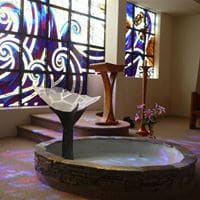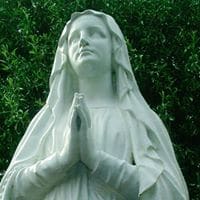
St Mary’s Parish Church is filled with lots of objects and windows, many of which are symbolic.
Here you can find out the meaning behind each symbol.
The Arrangement of the Church for Liturgical Assembly
The arrangement of the pews follows the ancient “monastic choir” formation, with people facing one another. The pews surround the altar and the lectern, enabling the gathered community to fully participate in the rites of the church.

The Ambo (Lectern) and Baptismal Font
The Ambo was placed opposite the Altar so the Book of the Gospels is processed across the church, allowing pause, time and focus for the Word of God soon to be proclaimed.
The Font allows for Baptism by immersion for infants and for copious water to be used for adult Baptism, which is more suitable as a symbol of participation in the death and resurrection of Christ.
The main window in the church is situated behind the ambo (lectern). It has the world depicted by O Wairaka (Mount Albert) with the houses of the Mt Albert parish on its slopes. Throughout the picture are the figures of the people of God, going about their daily lives.

The Church of God is depicted as a (waka) canoe, in Maori tradition a way to heaven and justice.
The figure of the crucified Christ forms the sternpost, from whose body flows out blood and water. This life of the church flows through its sacramental life in the great surge of the koru which make up the central panel and represent the sacraments.
The mystery of the Church flows through to the prow of the waka. Here the Maori myths of Maui , and Rangi and Papa, are transformed in Christ, spiraling up to a joining of earth and heaven.

Matthew Window
The Matthew window depicts the sick, the stranger, the hungry, the thirsty, the naked & the prisoner. The interlocking koru speak of both giver & receiver being the source of life. The two central panels – Hungry and Thirsty – are so positioned because of their Eucharistic significance (bread and wine).

The Exterior Stations of the Cross
The Scriptural Stations of the Cross are outside around the garden.In 1975, the Congregation for Sacred Rites suggested a list of Stations of the Cross more in keeping with the Gospel accounts. Keeping the number to fourteen the Congregation proposed that the devotion should adhere more correctly to the events related to us in the Sacred Scripture, and a more widespread use over the seasons of the Liturgical year. The stations in the grounds are based on the titles given by the Congregation.They were carved from the marble veneer of the old altar.